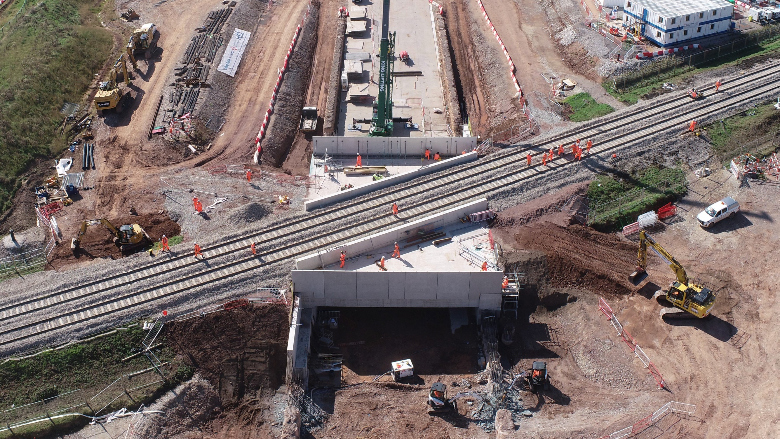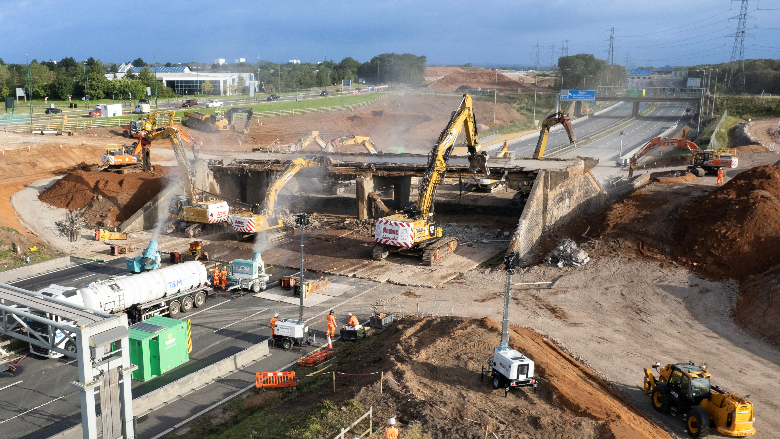With a variety of construction spread across some 350 sites, bridge builders have recently made their mark on the U.K.'s 140-mile HS2 London-Birmingham high-speed railroad. While it has had some individual success, the whole $50-billion megaproject risks going awry.
In its recent annual review, the government's Infrastructure and Projects Authority rated HS2's current chances of successful delivery as "unachievable." That was a downgrade on last year's assessment when success seemed feasible but challenging.
During the last financial year, the project company HS2 Ltd. met 11 of its 15 key schedule performance indicators for that period. Three of the missed four indicators arose from actions by third parties, according to the company.
While HS2 Ltd. has failed to meet the key schedule performance mark, it says it remains on course to complete the work "well in the range of 2029 to 2033."
But when the line will reach the central London terminal at Euston is still unknown. With costs rising, the government paused work at Euston in March. It also halted development of the roughly 40 miles from the line's northern end, at Fradley, to Crewe.
“The next 18-24 months will see the project move into an exciting new stage," noted HS2 Ltd. CEO Mark Thurston last month, resigning from his $800,000-a-year post. "Someone else should lead the organization and program through what will be another defining period for HS2," he added.
The project has moved from "a scheme in development to a major construction project that employs 28,500 people across the country," added HS2 Ltd. chair Jon Thompson, who will run the job from September until Thurston is replaced.
Meanwhile, on the ground construction teams are paving the way for the new line. Near Lichfield, about 12 miles from Birmingham, the Balfour Beatty VINCI joint venture (BBV) deployed around 150 people and 18 suppliers over 10 weeks to build the Streethay bridge to carry an existing railroad over the route of the high-speed line.
 HS2 completes the Streethay bridge under the South Staffordshire railway line. Photo courtesy of HS2 Ltd.
HS2 completes the Streethay bridge under the South Staffordshire railway line. Photo courtesy of HS2 Ltd.
The contractor excavated 15,400 tons of earth and built 460 ft of retaining walls under the line of the railroad. It then slid a 82-ft-long, 159-ft-wide concrete bridge completed nearby last month into place. With the new 2,900-ton deck positioned on the excavation walls, the original track was reinstated, and the line reopened in mid-August.
Coordinating multiple teams and interfaces of the slide was "no small task," according to Mark Jordan, the design director at the project's Mott MacDonald Systra Design Joint Venture
Meanwhile another BBV team a short distance along the line at Fulfen Wood hired Netherlands-based Mammoet to slide a 6,800-ton concrete box into a pre-excavated trench on an 840-wheel self-propelled transporter. The roof of the 184-ft-long, 62-ft-wide box will carry the main west coast railroad over HS2.
Just east of Birmingham, a BBV team used 10 large excavators to remove a 130-ft-long by 33-ft-wide road bridge deck weighing 4,400 tons in 56 hours. In its place, they will build a new 985-ft-long, 82-ft-wide concrete twin box to carry the line over the busy M42 motorway without impeding traffic.
 Crawler cranes removed a road bridge over the M42 motorway to make way for HS2. Photo courtesy of HS2 Ltd.
Crawler cranes removed a road bridge over the M42 motorway to make way for HS2. Photo courtesy of HS2 Ltd.
Further south, about 12 miles northwest of London, the Align joint venture of Bouygues Travaux Publics, Sir Robert McAlpine and VolkerFitzpatrick made most of the quiet holiday season to build one span of the country's longest railroad bridge over a local highway.
Rather than wait for the launch girder placing around 1,000 precast deck elements along the 2.1-mile-long Colne Valley Viaduct, the contractor raised 11 sections with a crane to form the 130-ft span. "As the launching girder hadn’t reached that point...we opted to go ahead with the work," says an HS2L spokesman.



Post a comment to this article
Report Abusive Comment